Pecharsky V.K., Zavalij P.Y. Fundamentals of Powder Diffraction and Structural Characterization of Materials
Подождите немного. Документ загружается.

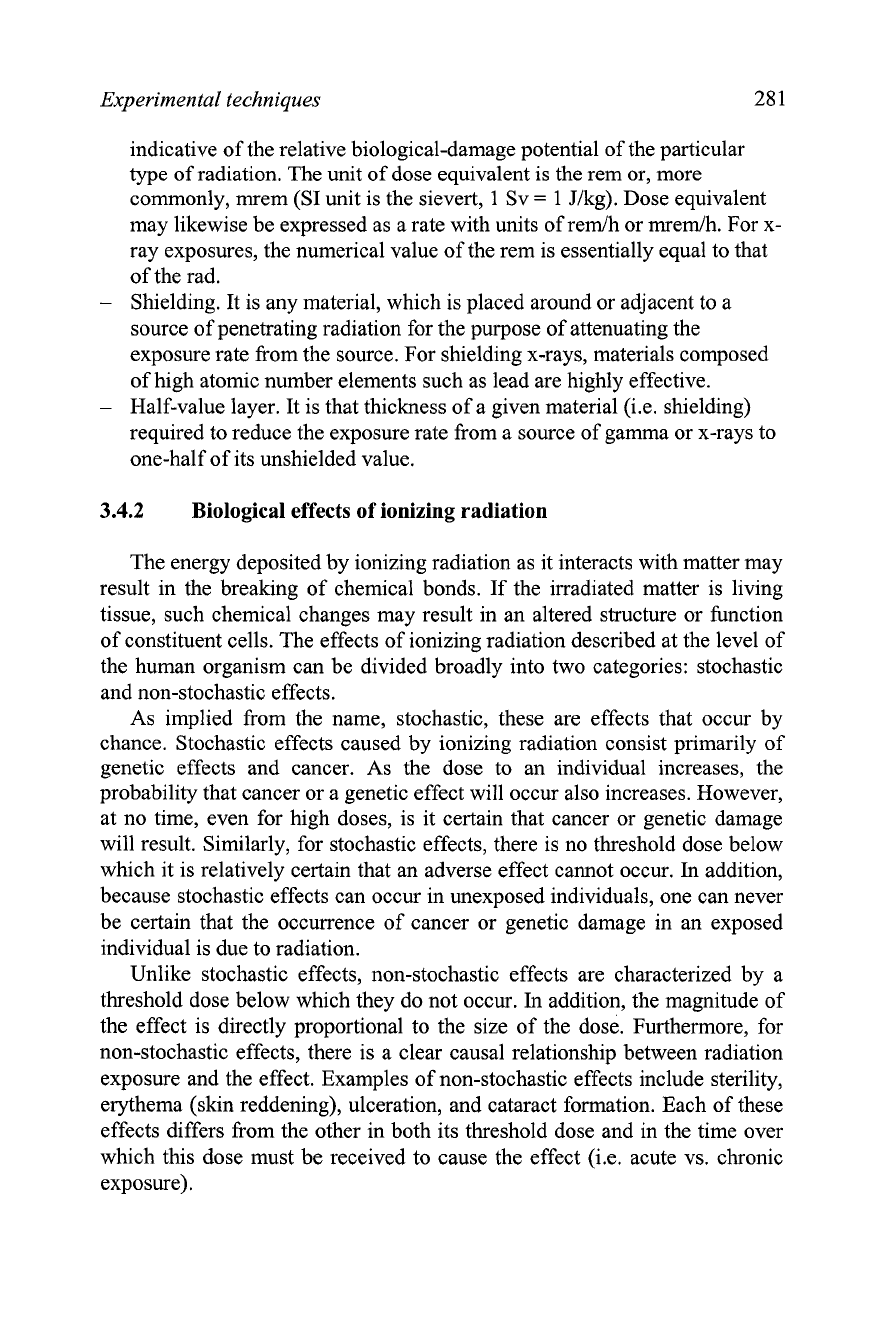
Experimental techniques
28
1
indicative of the relative biological-damage potential of the particular
type of radiation. The unit of dose equivalent is the rem or, more
commonly, rnrem (SI unit is the sievert,
1
Sv
=
1
Jlkg). Dose equivalent
may likewise be expressed as a rate with units of redh or mredh. For x-
ray exposures, the numerical value of the rem is essentially equal to that
of the rad.
-
Shielding. It is any material, which is placed around or adjacent to a
source of penetrating radiation for the purpose of attenuating the
exposure rate from the source. For shielding x-rays, materials composed
of high atomic number elements such as lead are highly effective.
-
Half-value layer. It is that thickness of a given material (i.e. shielding)
required to reduce the exposure rate from a source of gamma or x-rays to
one-half of its unshielded value.
3.4.2
Biological
effects
of
ionizing radiation
The energy deposited by ionizing radiation as it interacts with matter may
result in the breaking of chemical bonds. If the irradiated matter is living
tissue, such chemical changes may result in an altered structure or function
of constituent cells. The effects of ionizing radiation described at the level of
the human organism can be divided broadly into two categories: stochastic
and non-stochastic effects.
As implied from the name, stochastic, these are effects that occur by
chance. Stochastic effects caused by ionizing radiation consist primarily of
genetic effects and cancer. As the dose to an individual increases, the
probability that cancer or a genetic effect will occur also increases. However,
at no time, even for high doses, is it certain that cancer or genetic damage
will result. Similarly, for stochastic effects, there is no threshold dose below
which it is relatively certain that an adverse effect cannot occur.
In
addition,
because stochastic effects can occur in unexposed individuals, one can never
be certain that the occurrence of cancer or genetic damage in an exposed
individual is due to radiation.
Unlike stochastic effects, non-stochastic effects are characterized by a
threshold dose below which they do not occur.
In
addition, the magnitude of
the effect is directly proportional to the size of the dose. Furthermore, for
non-stochastic effects, there is a clear causal relationship between radiation
exposure and the effect. Examples of non-stochastic effects include sterility,
erythema (skin reddening), ulceration, and cataract formation. Each of these
effects differs from the other in both its threshold dose and in the time over
which this dose must be received to cause the effect
(i.e. acute vs. chronic
exposure).
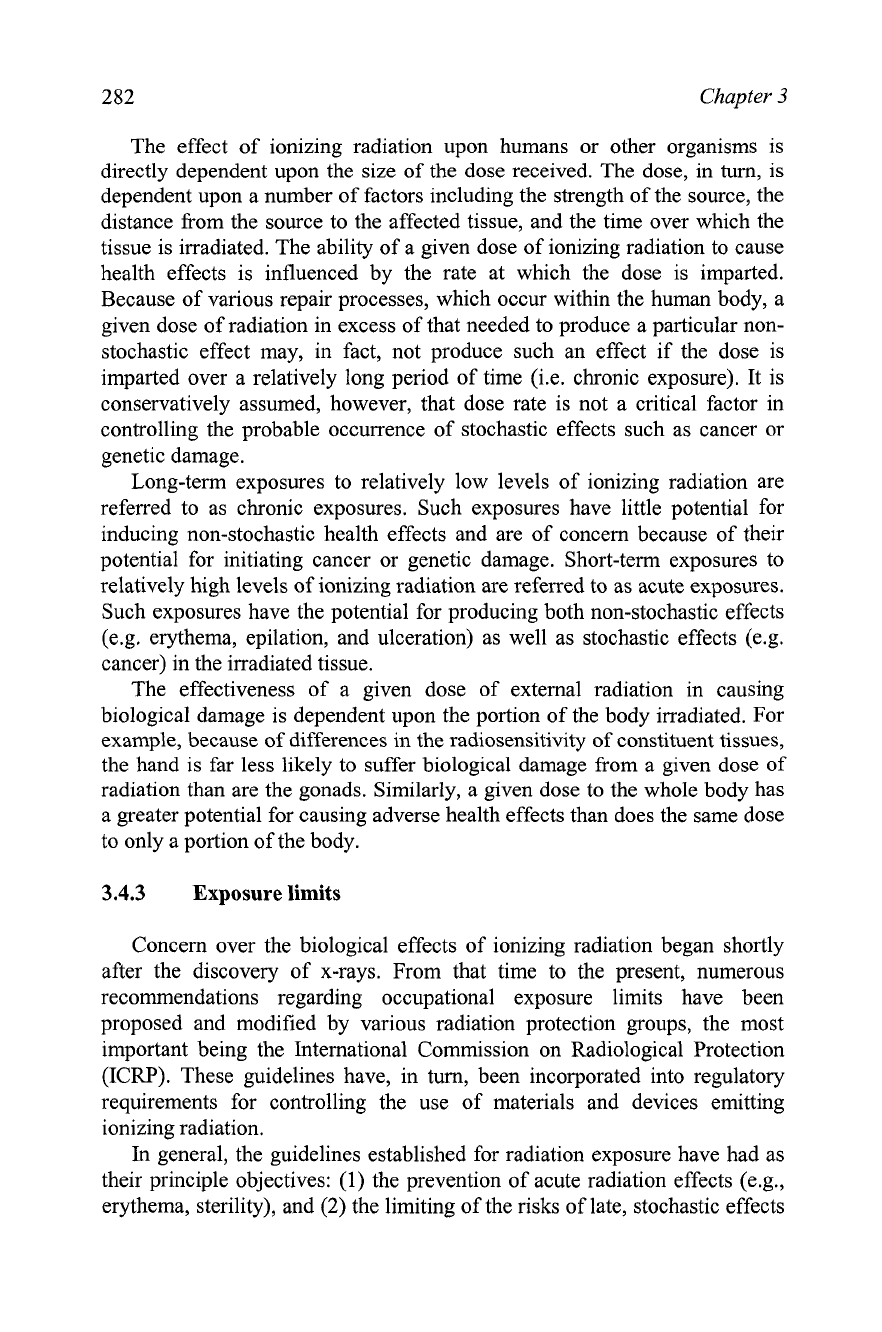
282
Chapter
3
The effect of ionizing radiation upon humans or other organisms is
directly dependent upon the size of the dose received. The dose, in
turn,
is
dependent upon a number of factors including the strength of the source, the
distance from the source to the affected tissue, and the time over which the
tissue is irradiated. The ability of a given dose of ionizing radiation to cause
health effects is influenced by the rate at which the dose is imparted.
Because of various repair processes, which occur within the human body, a
given dose of radiation in excess of that needed to produce a particular
non-
stochastic effect may, in fact, not produce such an effect if the dose is
imparted over a relatively long period of time (i.e. chronic exposure). It is
conservatively assumed, however, that dose rate is not a critical factor in
controlling the probable occurrence of stochastic effects such as cancer or
genetic damage.
Long-term exposures to relatively low levels of ionizing radiation are
referred to as chronic exposures. Such exposures have little potential for
inducing non-stochastic health effects and are of concern because of their
potential for initiating cancer or genetic damage. Short-term exposures to
relatively high levels of ionizing radiation are referred to as acute exposures.
Such exposures have the potential for producing both non-stochastic effects
(e.g. erythema, epilation, and ulceration) as well as stochastic effects (e.g.
cancer) in the irradiated tissue.
The effectiveness of a given dose of external radiation in causing
biological damage is dependent upon the portion of the body irradiated. For
example, because of differences in the radiosensitivity of constituent tissues,
the hand is far less likely to suffer biological damage from a given dose of
radiation than are the gonads. Similarly, a given dose to the whole body has
a greater potential for causing adverse health effects than does the same dose
to only a portion of the body.
3.4.3
Exposure limits
Concern over the biological effects of ionizing radiation began shortly
after the discovery of x-rays. From that time to the present, numerous
recommendations regarding occupational exposure limits have been
proposed and modified by various radiation protection groups, the most
important being the International Commission on Radiological Protection
(10). These guidelines have, in turn, been incorporated into regulatory
requirements for controlling the use of materials and devices emitting
ionizing radiation.
In
general, the guidelines established for radiation exposure have had as
their principle objectives:
(1)
the prevention of acute radiation effects (e.g.,
erythema, sterility), and (2) the limiting of the risks of late, stochastic effects
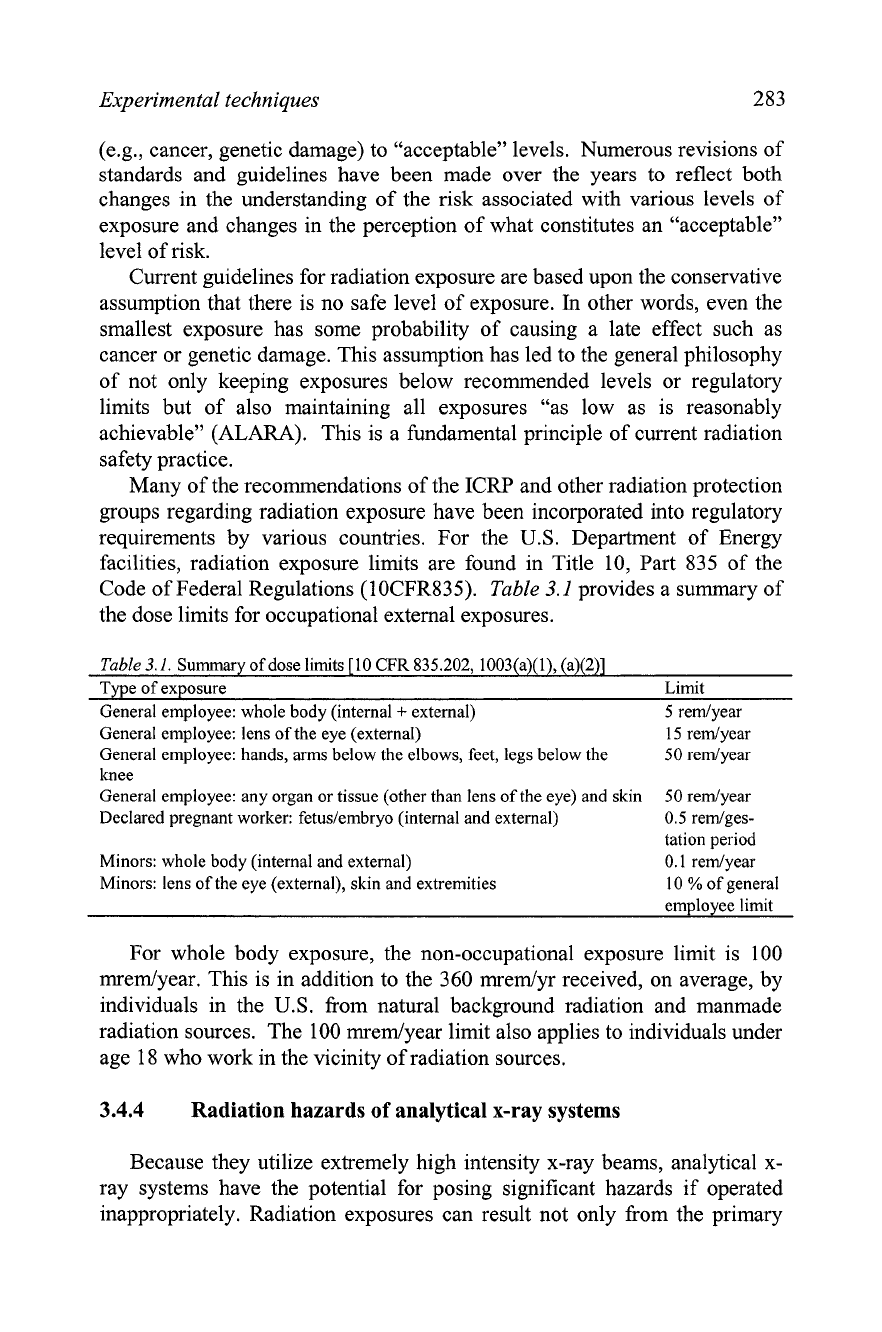
Experimental techniques
283
(e.g., cancer, genetic damage) to "acceptable" levels. Numerous revisions of
standards and guidelines have been made over the years to reflect both
changes in the understanding of the risk associated with various levels of
exposure and changes in the perception of what constitutes an "acceptable"
level of risk.
Current guidelines for radiation exposure are based upon the conservative
assumption that there is no safe level of exposure.
In
other words, even the
smallest exposure has some probability of causing a late effect such as
cancer or genetic damage. This assumption has led to the general philosophy
of not only keeping exposures below recommended levels or regulatory
limits but of also maintaining all exposures "as low as is reasonably
achievable"
(ALARA).
This is a fundamental principle of current radiation
safety practice.
Many of the recommendations of the ICRP and other radiation protection
groups regarding radiation exposure have been incorporated into regulatory
requirements by various countries. For the
U.S.
Department of Energy
facilities, radiation exposure limits are found in Title 10, Part 835 of the
Code of Federal Regulations
(10CFR835).
Table
3.1
provides a summary of
the dose limits for occupational external exposures.
Table
3.1.
Summary of dose limits [lo
CFR
835.202, 1003(a)(l), (a)(2)]
Type of exposure Limit
General employee: whole body (internal
+
external)
5
redyear
General employee: lens of the eye (external) 15 redyear
General employee: hands, arms below the elbows, feet, legs below the 50 redyear
knee
General employee: any organ or tissue (other than lens of the eye) and skin 50 redyear
Declared pregnant worker: fetus/embryo (internal and external) 0.5 redges-
tation period
Minors: whole body (internal and external)
0.1
redyear
Minors: lens
of
the eye (external), skin and extremities 10
%
of general
employee limit
For whole body exposure, the non-occupational exposure limit is 100
mredyear. This is in addition to the 360 mremtyr received, on average, by
individuals in the
U.S.
from natural background radiation and manmade
radiation sources. The 100 rnrernlyear limit also applies to individuals under
age 18 who work in the vicinity of radiation sources.
3.4.4
Radiation hazards of analytical x-ray systems
Because they utilize extremely high intensity x-ray beams, analytical x-
ray systems have the potential for posing significant hazards if operated
inappropriately. Radiation exposures can result not only from the primary
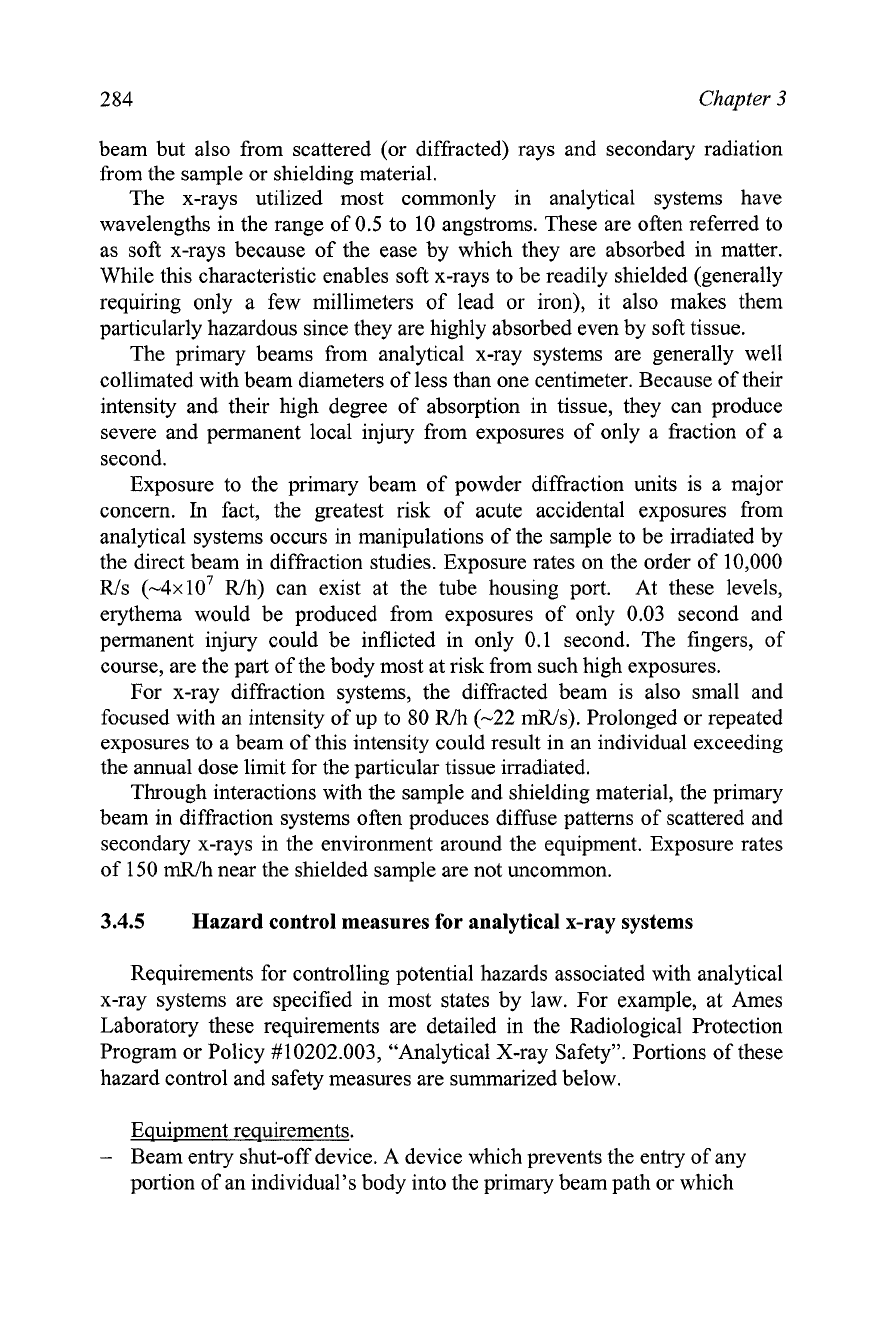
284
Chapter
3
beam but also from scattered (or diffracted) rays and secondary radiation
from the sample or shielding material.
The x-rays utilized most commonly in analytical systems have
wavelengths in the range of 0.5 to 10 angstroms. These are often referred to
as soft x-rays because of the ease by which they are absorbed in matter.
While this characteristic enables soft x-rays to be readily shielded (generally
requiring only a few millimeters of lead or iron), it also makes them
particularly hazardous since they are highly absorbed even by soft tissue.
The primary beams from analytical x-ray systems are generally well
collimated with beam diameters of less than one centimeter. Because of their
intensity and their high degree of absorption in tissue, they can produce
severe and permanent local injury from exposures of only a fraction of a
second.
Exposure to the primary beam of powder diffraction units is a major
concern.
In
fact, the greatest risk of acute accidental exposures from
analytical systems occurs in manipulations of the sample to be irradiated by
the direct beam in diffraction studies. Exposure rates on the order of 10,000
lUs (-4x10~
R/h)
can exist at the tube housing port. At these levels,
erythema would be produced from exposures of only 0.03 second and
permanent injury could be inflicted in only 0.1 second. The fingers, of
course, are the part of the body most at risk from such high exposures.
For x-ray diffraction systems, the diffracted beam is also small and
focused with an intensity of up to 80 lUh (-22 rnR/s). Prolonged or repeated
exposures to a beam of this intensity could result in an individual exceeding
the annual dose limit for the particular tissue irradiated.
Through interactions with the sample and shielding material, the primary
beam in diffraction systems often produces diffuse patterns of scattered and
secondary x-rays in the environment around the equipment. Exposure rates
of 150
mlUh
near the shielded sample are not uncommon.
3.4.5
Hazard control measures for analytical x-ray systems
Requirements for controlling potential hazards associated with analytical
x-ray systems are specified in most states by law. For example, at Ames
Laboratory these requirements are detailed in the Radiological Protection
Program or Policy
#10202.003, "Analytical X-ray Safety". Portions of these
hazard control and safety measures are summarized below.
Equipment requirements.
-
Beam entry shut-off device. A device which prevents the entry of any
portion of an individual's body into the primary beam path or which
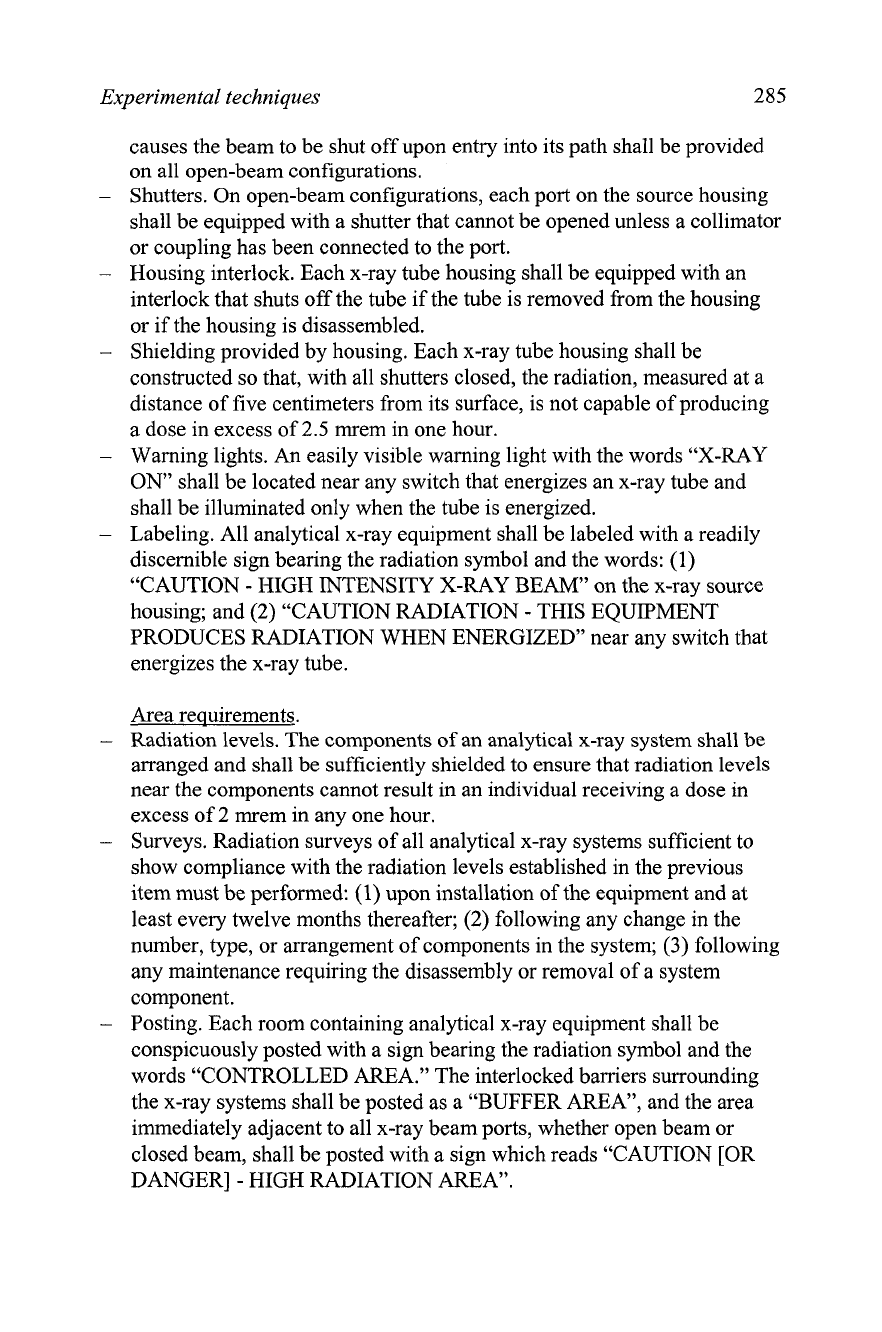
Experimental techniques
285
causes the beam to be shut off upon entry into its path shall be provided
on all open-beam configurations.
-
Shutters. On open-beam configurations, each port on the source housing
shall be equipped with a shutter that cannot be opened unless a collimator
or coupling has been connected to the port.
-
Housing interlock. Each x-ray tube housing shall be equipped with an
interlock that shuts off the tube if the tube is removed from the housing
or if the housing is disassembled.
-
Shielding provided by housing. Each x-ray tube housing shall be
constructed so that, with all shutters closed, the radiation, measured at a
distance of five centimeters from its surface, is not capable of producing
a dose in excess of
2.5 mrem in one hour.
-
Warning lights.
An
easily visible warning light with the words
"X-RAY
ON" shall be located near any switch that energizes an x-ray tube and
shall be illuminated only when the tube is energized.
-
Labeling. All analytical x-ray equipment shall be labeled with a readily
discernible sign bearing the radiation symbol and the words:
(1)
"CAUTION
-
HIGH INTENSITY
X-RAY
BEAM" on the x-ray source
housing; and
(2)
"CAUTION RADIATION
-
THIS EQUIPMENT
PRODUCES RADIATION WHEN ENERGIZED" near any switch that
energizes the x-ray tube.
Area requirements.
-
Radiation levels. The components
of
an analytical x-ray system shall be
arranged and shall be sufficiently shielded to ensure that radiation levels
near the components cannot result in an individual receiving a dose in
excess of 2 mrem in any one hour.
-
Surveys. Radiation surveys of all analytical x-ray systems sufficient to
show compliance with the radiation levels established in the previous
item must be performed: (1) upon installation of the equipment and at
least every twelve months thereafter; (2) following any change in the
number, type, or arrangement of components in the system;
(3)
following
any maintenance requiring the disassembly or removal of a system
component.
-
Posting. Each room containing analytical x-ray equipment shall be
conspicuously posted with a sign bearing the radiation symbol and the
words "CONTROLLED AREA." The interlocked barriers surrounding
the x-ray systems shall be posted as a "BUFFER AREA, and the area
immediately adjacent to all x-ray beam ports, whether open beam or
closed beam, shall be posted with a sign which reads "CAUTION [OR
DANGER]
-
HIGH RADIATION AREA".
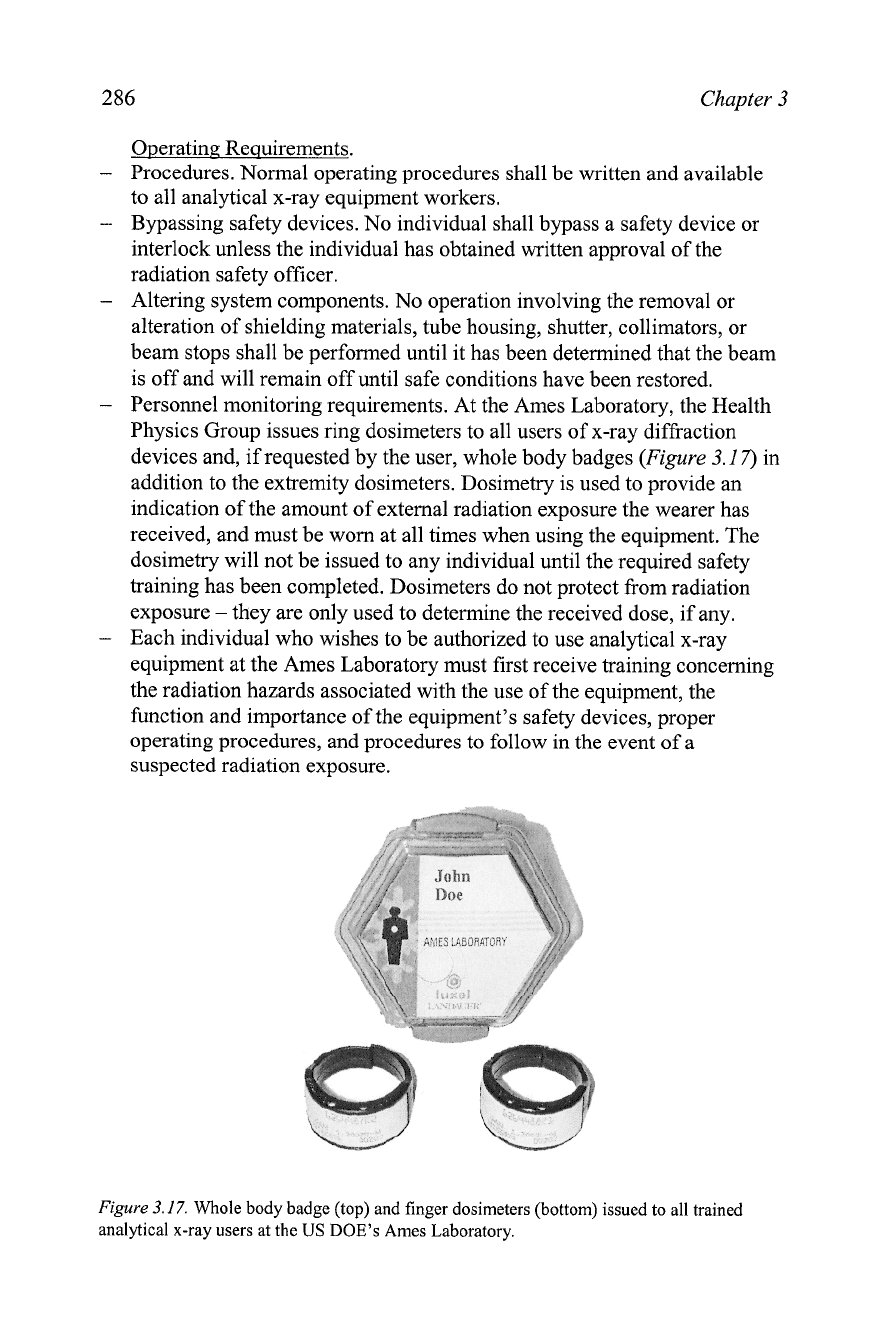
286
Chapter
3
Operating Requirements.
Procedures. Normal operating procedures shall be written and available
to all analytical x-ray equipment workers.
Bypassing safety devices. No individual shall bypass a safety device or
interlock unless the individual has obtained written approval of the
radiation safety officer.
Altering system components. No operation involving the removal or
alteration of shielding materials, tube housing, shutter, collimators, or
beam stops shall be performed until it has been determined that the beam
is off and will remain off until safe conditions have been restored.
Personnel monitoring requirements. At the Ames Laboratory, the Health
Physics Group issues ring dosimeters to all users of x-ray diffraction
devices and, if requested by the user, whole body badges
(Figure
3.17) in
addition to the extremity dosimeters. Dosimetry is used to provide an
indication of the amount of external radiation exposure the wearer has
received, and must be worn at all times when using the equipment. The
dosimetry will not be issued to any individual until the required safety
training has been completed. Dosimeters do not protect from radiation
exposure
-
they are only used to determine the received dose, if any.
Each individual who wishes to be authorized to use analytical x-ray
equipment at the Ames Laboratory must first receive training concerning
the radiation hazards associated with the use of the equipment, the
function and importance of the equipment's safety devices, proper
operating procedures, and procedures to follow in the event of a
suspected radiation exposure.
Figure
3.17.
Whole body badge (top) and finger dosimeters (bottom) issued to all trained
analytical x-ray users at the
US
DOE'S Ames Laboratory.
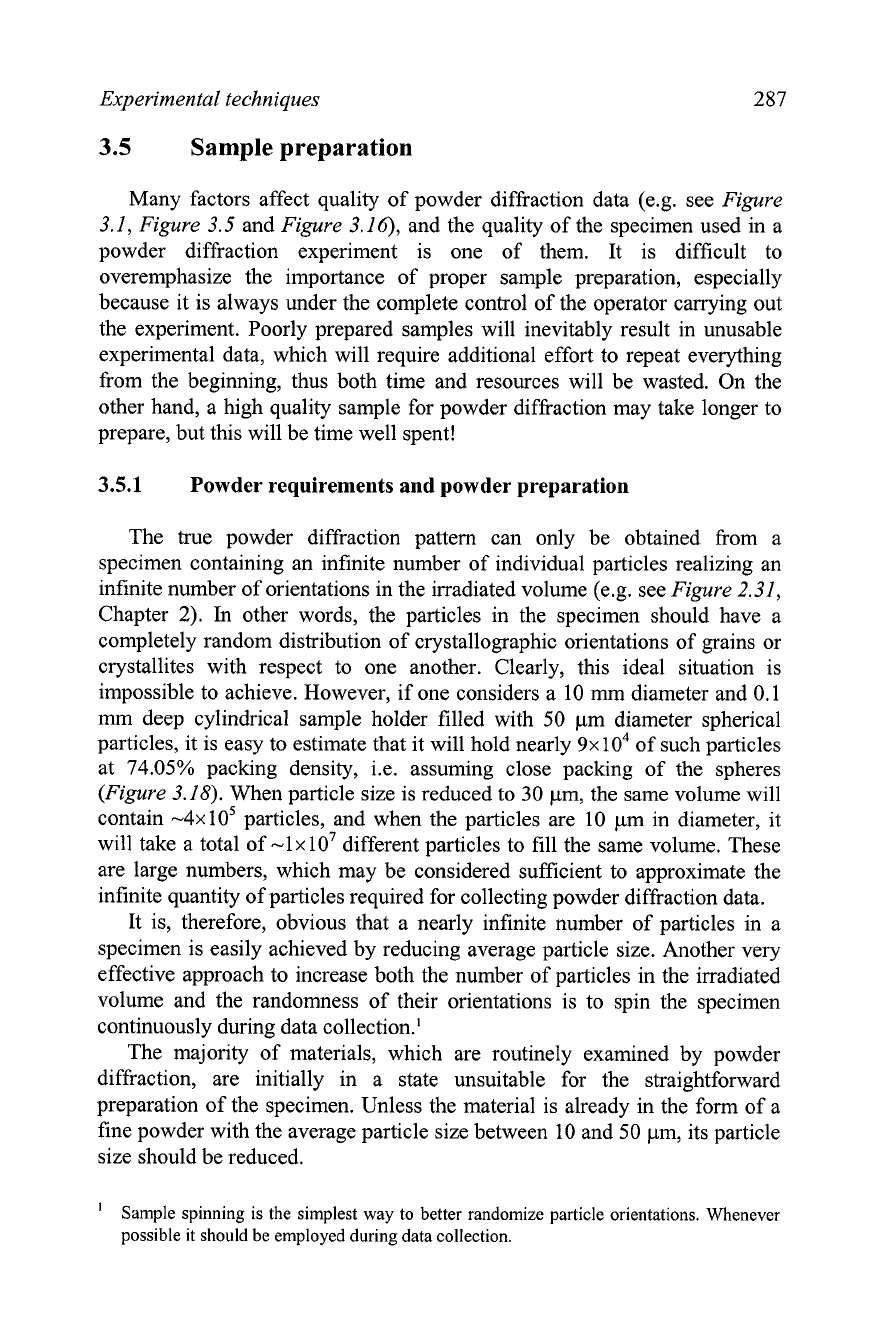
Experimental techniques
287
3.5
Sample preparation
Many factors affect quality of powder diffraction data (e.g. see
Figure
3.1,
Figure
3.5 and
Figure
3.16), and the quality of the specimen used in a
powder diffraction experiment is one of them. It is difficult to
overemphasize the importance of proper sample preparation, especially
because it is always under the complete control of the operator
carrying out
the experiment. Poorly prepared samples will inevitably result in unusable
experimental data, which will require additional effort to repeat everything
from the beginning, thus both time and resources will be wasted. On the
other hand, a high quality sample for powder diffraction may take longer to
prepare, but this will be time well spent!
3.5.1
Powder requirements and powder preparation
The true powder diffraction pattern can only be obtained from a
specimen containing an infinite number of individual particles realizing an
infinite number of orientations in the irradiated volume (e.g. see
Figure
2.31,
Chapter
2).
In
other words, the particles in the specimen should have a
completely random distribution of crystallographic orientations of grains or
crystallites with respect to one another. Clearly, this ideal situation is
impossible to achieve. However, if one considers a 10 mm diameter and 0.1
mm deep cylindrical sample holder filled with 50 pm diameter spherical
particles, it is easy to estimate that it will hold nearly 9x
lo4
of such particles
at 74.05% packing density, i.e. assuming close packing of the spheres
(Figure
3.18).
When particle size is reduced to 30 pm, the same volume will
contain -4x105 particles, and when the particles are 10 pm in diameter, it
will take a total of -lxlo7 different particles to fill the same volume. These
are large numbers, which may be considered sufficient to approximate the
infinite quantity of particles required for collecting powder diffraction data.
It is, therefore, obvious that a nearly infinite number of particles in a
specimen is easily achieved by reducing average particle size. Another very
effective approach to increase both the number of particles in the irradiated
volume and the randomness of their orientations is to spin the specimen
continuously during data collection.'
The majority of materials, which are routinely examined by powder
diffraction, are initially in a state unsuitable for the straightforward
preparation of the specimen. Unless the material is already in the form of a
fine powder with the average particle size between 10 and 50 pm, its particle
size should be reduced.
'
Sample spinning is the simplest way to better randomize particle orientations. Whenever
possible it should be employed during data collection.
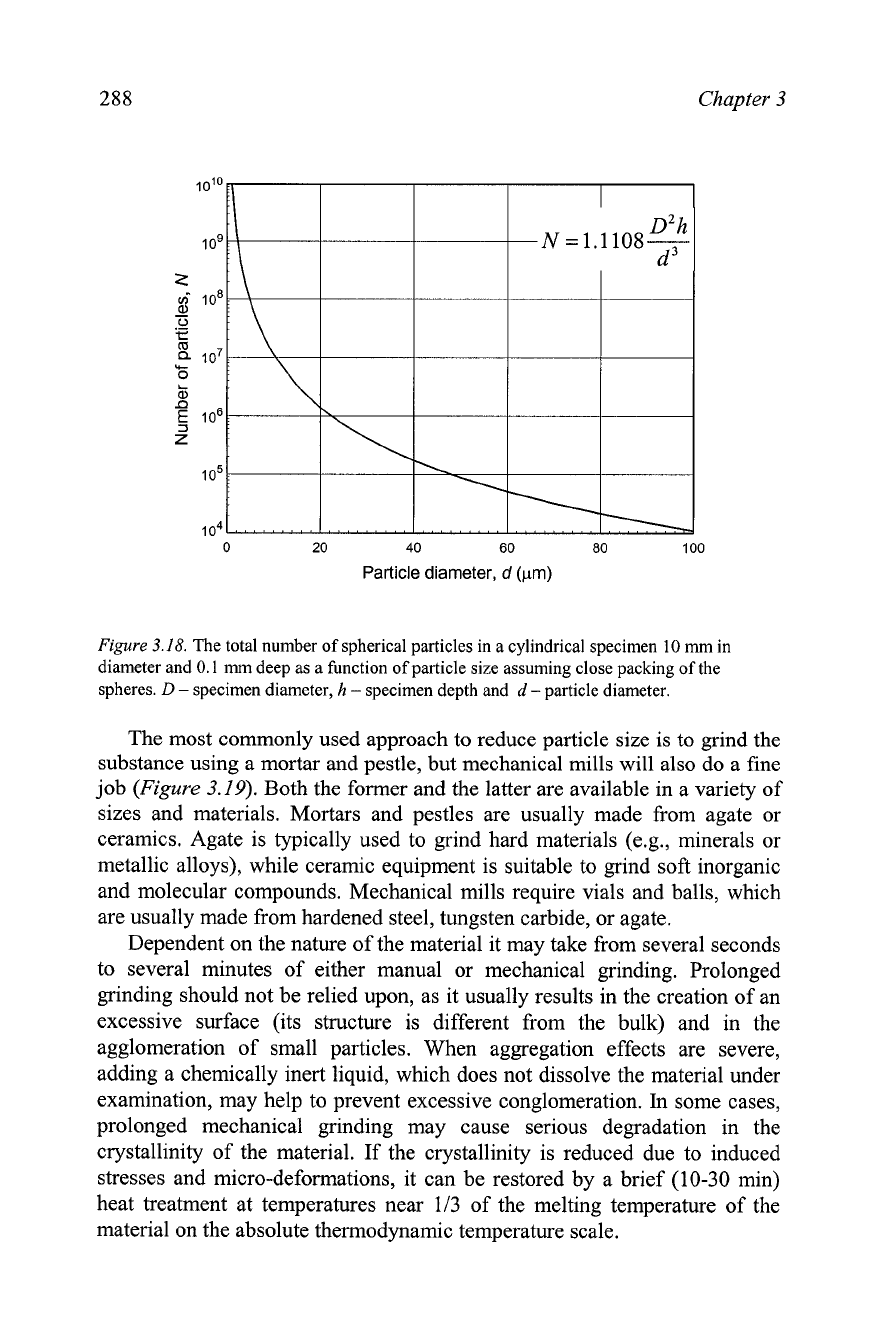
Chapter
3
0
20
40
60
80
100
Particle diameter,
d
(pm)
Figure
3.18.
The total number of spherical particles in a cylindrical specimen 10
rnrn
in
diameter and 0.1
mm
deep as a function of particle size assuming close packing of the
spheres.
D
-
specimen diameter,
h
-
specimen depth and
d
-
particle diameter.
The most commonly used approach to reduce particle size is to grind the
substance using a mortar and pestle, but mechanical mills will also do a fine
job
(Figure
3.19).
Both the former and the latter are available in a variety of
sizes and materials. Mortars and pestles are usually made from agate or
ceramics. Agate is typically used to grind hard materials
(e.g., minerals or
metallic alloys), while ceramic equipment is suitable to grind soft inorganic
and molecular compounds. Mechanical mills require vials and balls, which
are usually made from hardened steel, tungsten carbide, or agate.
Dependent on the nature of the material it may take from several seconds
to several minutes of either manual or mechanical grinding. Prolonged
grinding should not be relied upon, as it usually results in the creation of an
excessive surface (its structure is different from the bulk) and in the
agglomeration of small particles. When aggregation effects are severe,
adding a chemically inert liquid, which does not dissolve the material under
examination, may help to prevent excessive conglomeration.
In
some cases,
prolonged mechanical grinding may cause serious degradation in the
crystallinity of the material. If the crystallinity is reduced due to induced
stresses and micro-deformations, it can be restored by a brief (10-30 min)
heat treatment at temperatures near
113
of the melting temperature of the
material on the absolute thermodynamic temperature scale.
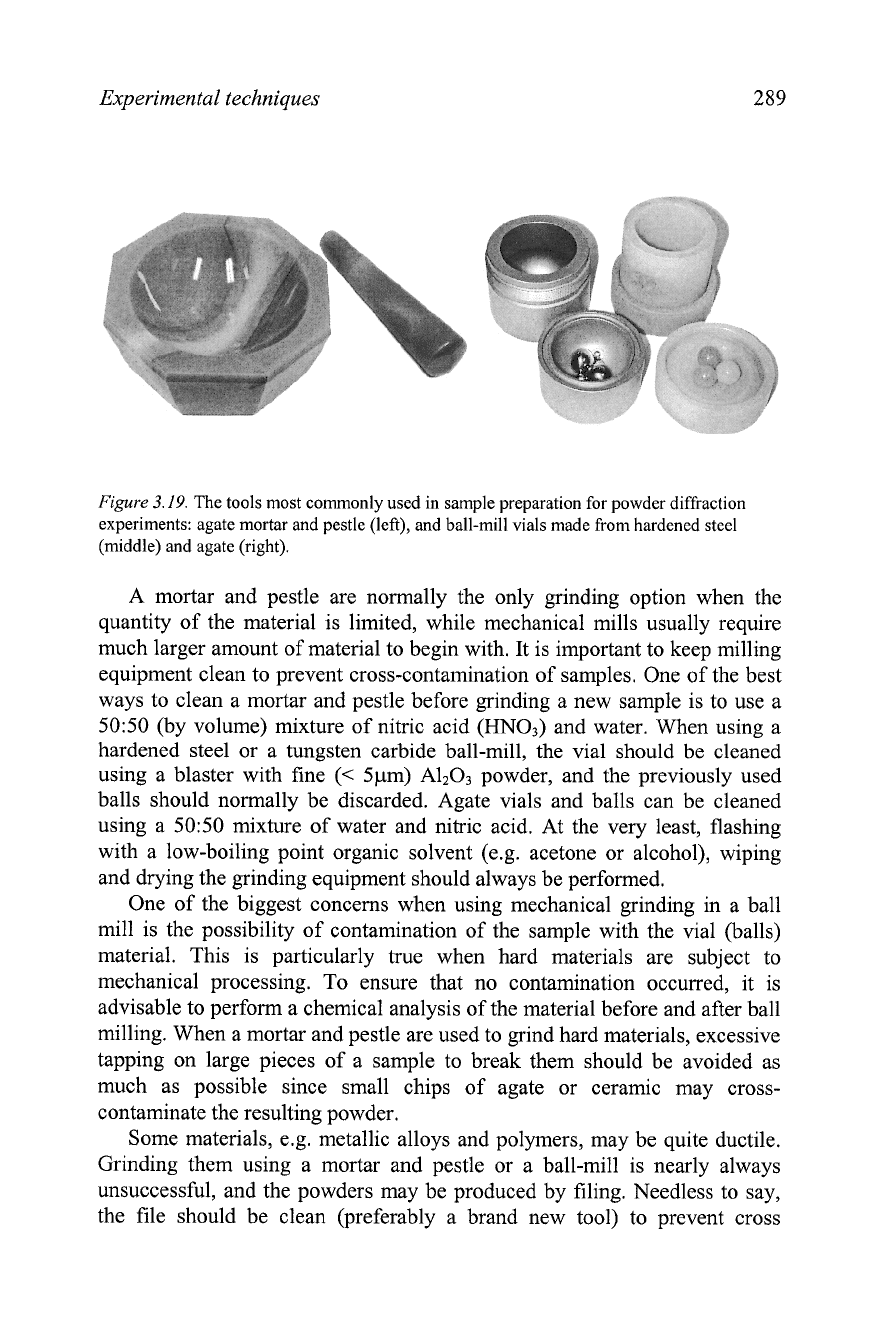
Experimental
techniques
Figure
3.19.
The tools most commonly used in sample preparation for powder diffraction
experiments: agate mortar and pestle (left), and ball-mill vials made from hardened steel
(middle) and agate (right).
A mortar and pestle are normally the only grinding option when the
quantity of the material is limited, while mechanical mills usually require
much larger amount of material to begin with. It is important to keep milling
equipment clean to prevent cross-contamination of samples. One of the best
ways to clean a mortar and pestle before grinding a new sample is to use a
5050
(by volume) mixture of nitric acid (HN03) and water. When using a
hardened steel or a tungsten carbide ball-mill, the vial should
be
cleaned
using a blaster with fine
(<
5pm) A1203 powder, and the previously used
balls should normally be discarded. Agate vials and balls can be cleaned
using
a
5050
mixture of water and nitric acid. At the very least, flashing
with a low-boiling point organic solvent (e.g. acetone or alcohol), wiping
and drying the grinding equipment should always be performed.
One of the biggest concerns when using mechanical grinding in a ball
mill is the possibility of contamination of the sample with the vial (balls)
material. This is particularly true when hard materials are subject to
mechanical processing. To ensure that no contamination occurred, it is
advisable to perform a chemical analysis of the material before and after ball
milling. When a mortar and pestle are used to grind hard materials, excessive
tapping on large pieces of a sample to break them should be avoided as
much as possible since small chips of agate or ceramic may cross-
contaminate the resulting powder.
Some materials, e.g. metallic alloys and polymers, may be quite ductile.
Grinding them using a mortar and pestle or a ball-mill is nearly always
unsuccessful, and the powders may be produced by filing. Needless to say,
the file should be clean (preferably a brand new tool) to prevent cross
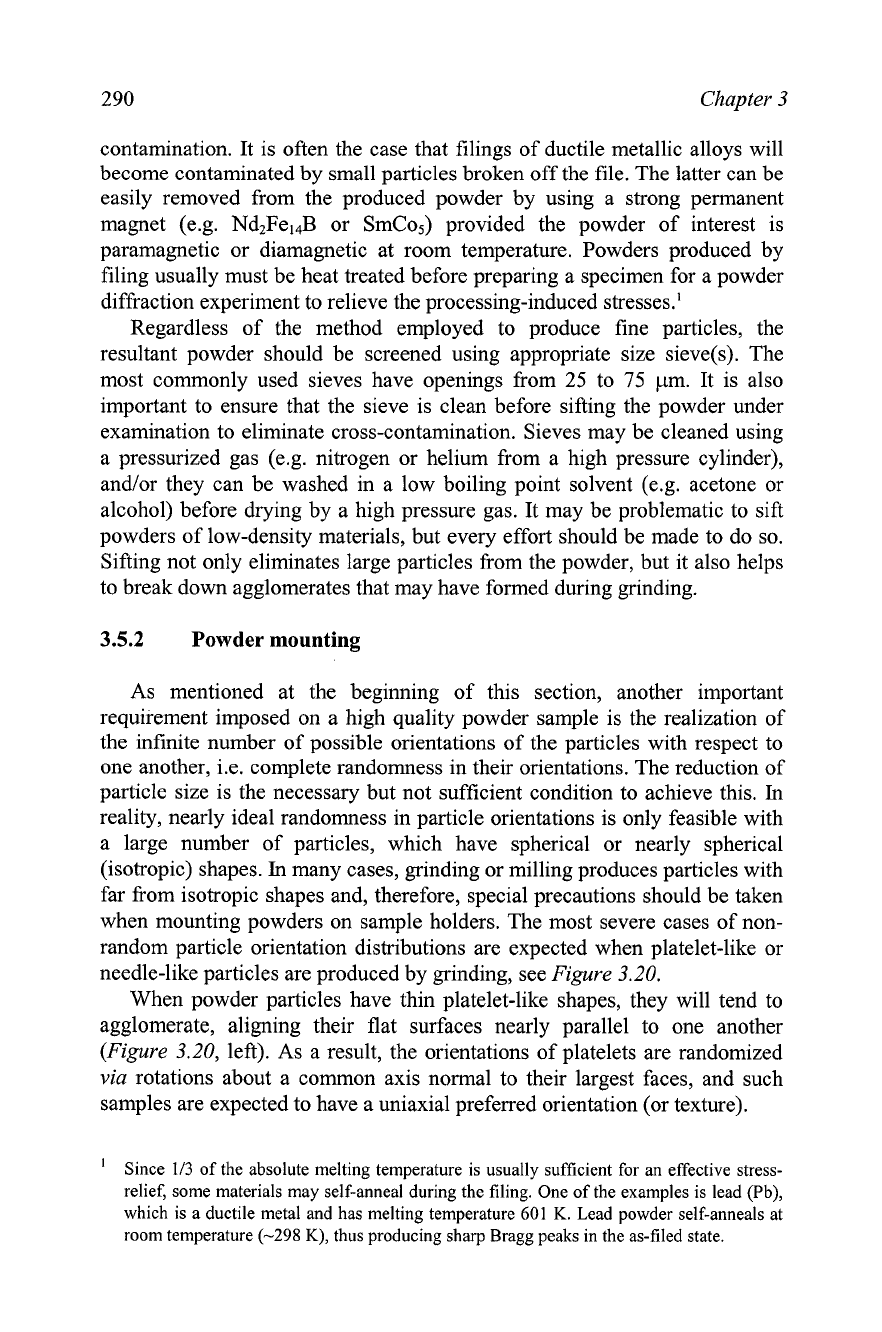
Chapter 3
contamination. It is often the case that filings of ductile metallic alloys will
become contaminated by small particles broken off the file. The latter can be
easily removed from the produced powder by using a strong permanent
magnet
(e.g. Nd2Fe14B or SmCo5) provided the powder of interest is
paramagnetic or diamagnetic at room temperature. Powders produced by
filing usually must be heat treated before preparing a specimen for a powder
diffraction experiment to relieve the processing-induced stresses.'
Regardless of the method employed to produce fine particles, the
resultant powder should be screened using appropriate size
sieve(s). The
most commonly used sieves have openings from
25
to
75
ym. It is also
important to ensure that the sieve is clean before sifting the powder under
examination to eliminate cross-contamination. Sieves may be cleaned using
a pressurized gas
(e.g. nitrogen or helium from a high pressure cylinder),
andlor they can be washed in a low boiling point solvent (e.g. acetone or
alcohol) before drying by a high pressure gas. It may be problematic to sift
powders of low-density materials, but every effort should be made to do so.
Sifting not only eliminates large particles from the powder, but it also helps
to break down agglomerates that may have formed during grinding.
3.5.2
Powder
mounting
As mentioned at the beginning of this section, another important
requirement imposed on a high quality powder sample is the realization of
the infinite number of possible orientations of the particles with respect to
one another, i.e. complete randomness in their orientations. The reduction of
particle size is the necessary but not sufficient condition to achieve this.
In
reality, nearly ideal randomness in particle orientations is only feasible with
a large number of particles, which have spherical or nearly spherical
(isotropic) shapes.
In
many cases, grinding or milling produces particles with
far from isotropic shapes and, therefore, special precautions should be taken
when mounting powders on sample holders. The most severe cases of non-
random particle orientation distribution~ are expected when platelet-like or
needle-like particles are produced by grinding, see Figure 3.20.
When powder particles have thin platelet-like shapes, they will tend to
agglomerate, aligning their flat surfaces nearly parallel to one another
(Figure 3.20, left). As a result, the orientations of platelets are randomized
via rotations about a common axis normal to their largest faces, and such
samples are expected to have a uniaxial preferred orientation (or texture).
'
Since
113
of the absolute melting temperature is usually sufficient for an effective stress-
relief, some materials may self-anneal during the filing. One of the examples is lead (Pb),
which is a ductile metal and has melting temperature
601
K. Lead powder self-anneals at
room temperature
(-298
K), thus producing sharp Bragg peaks in the as-filed state.
